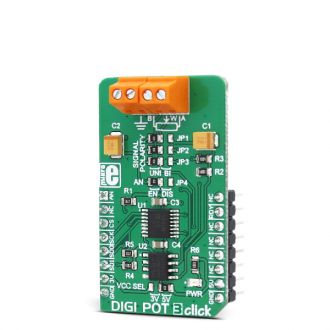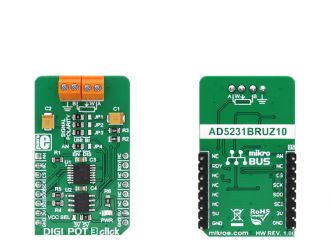
We strongly encourage users to use Package manager for sharing their code on Libstock website, because it boosts your efficiency and leaves the end user with no room for error. [more info]

Rating:
Author: MIKROE
Last Updated: 2018-05-16
Package Version: 1.0.0.0
mikroSDK Library: 1.0.0.0
Category: Digital potentiometer
Downloaded: 5769 times
Not followed.
License: MIT license
DIGI POT 3 click is a versatile and feature-rich digital potentiometer click with 1024 steps and an internal non-volatile memory (EEMEM), which can be used for storing the wiper position, but also for storing various user data.
Do you want to subscribe in order to receive notifications regarding "DIGI POT 3 click" changes.
Do you want to unsubscribe in order to stop receiving notifications regarding "DIGI POT 3 click" changes.
Do you want to report abuse regarding "DIGI POT 3 click".


Library Description
The library performs the check procedure for the desired outputs (IN1 - IN4). For more details check the documentation.
Key functions:
Examples Description
The demo application is composed of three sections:
void applicationTask()
{
while (digitalValue < 0x0200)
{
digipot3_sendCommand( _DIGIPOT3_INCREMENT_RDAC_6DB_COMM );
digipot3_readDAC( &digitalValue );
WordToStr( digitalValue, text );
mikrobus_logWrite( "DAC value is: ", _LOG_TEXT );
mikrobus_logWrite( text, _LOG_LINE );
Delay_ms( 2000 );
}
while (digitalValue > 0x0002)
{
digipot3_sendCommand( _DIGIPOT3_DECREMENT_RDAC_6DB_COMM );
digipot3_readDAC( &digitalValue );
WordToStr( digitalValue, text );
mikrobus_logWrite( "DAC value is: ", _LOG_TEXT );
mikrobus_logWrite( text, _LOG_LINE );
Delay_ms( 2000 );
}
if (eememValue != digitalValue)
{
digipot3_sendCommand( _DIGIPOT3_STORE_RDAC_TO_EEMEM_COMM );
eememValue = digitalValue;
}
}
mikroE Libraries used in the example:
Additional notes and information
Depending on the development board you are using, you may need USB UART click, USB UART 2 click or RS232 click to connect to your PC, for development systems with no UART to USB interface available on the board. The terminal available in all MikroElektronika compilers, or any other terminal application of your choice, can be used to read the message.